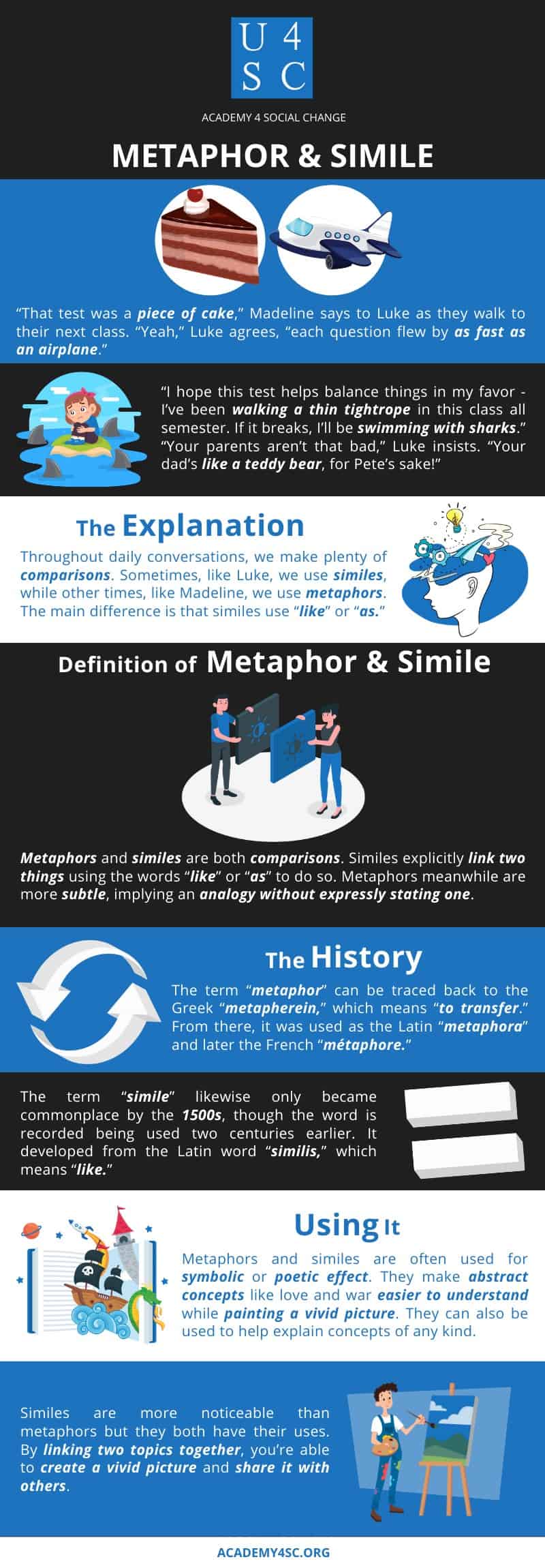Have You Ever?
“That test was a piece of cake,” Madeline says to Luke as they walk to their next class.
“Yeah,” Luke agrees, “each question flew by as fast as an airplane.”
“I hope this test helps balance things more in my favor - I’ve been walking a thin tightrope in this class all semester. If it breaks, I’ll be swimming with sharks.”
“Your parents aren’t that bad,” Luke insists. “Your dad’s like a teddy bear, for Pete’s sake!”
The Explanation
Throughout daily conversations, we make plenty of comparisons. Sometimes, like Luke, we use similes, while other times, like Madeline, we use metaphors. The main difference is that similes use “like” or “as.”
Definition of Metaphor & Simile
Metaphors and similes are both comparisons. Similes explicitly link two things using the words “like” or “as” to do so. Metaphors, meanwhile, are more subtle, implying an analogy without expressly stating one. One trick for remembering the difference between a simile and a metaphor is that the words “like” and “simile” both have “i”s in them and “as” and “simile” both have an “s.” Remember that these rhetorical devices are a figurative linking of subjects - they’re not stating the two things are exactly the same but rather that there is a resemblance between them.
The History
The term “metaphor” can be traced back to the Greek “metapherein,” which means “to transfer.” From there, it was used as the Latin “metaphora” and later the French “métaphore.” Thus, while the modern term “metaphor” only became regularly used by the 1500s, its definition was well known centuries beforehand.
The term “simile” likewise only became commonplace by the 1500s, though the word is recorded being used two centuries earlier. It developed from the Latin word “similis,” which means “like.”
Using It
Metaphors and similes are used for symbolic or poetic effect. It’s understandable then why they’re employed so often in songs, poetry, and literature. They make abstract concepts like love and war easier to understand while painting a vivid picture. Emily Dickinson regularly employs metaphors to this effect: ““Hope” is the thing with feathers - / That perches in the soul - / And sings the tune without the words - / And never stops – at all -”. Metaphors are more often used than similes when the speaker wants to create a dramatic or very passionate piece. However, similes can express a point just as clearly and beautifully, like in Margaret Mitchell’s Gone with the Wind: “the very mystery of him excited her curiosity like a door that had neither lock nor key.”
These rhetorical devices aren’t only limited to the realm of storytelling. Since metaphors and similes are used to help convey an author’s ideas vividly, they can be used to help explain concepts of any kind. Similes are more often used for this purpose, although metaphors can be employed as well. For example, say you had to explain what a live stream was. You might say, “It’s like any other public video you find on the web, only you’re sharing the video and audio in real-time, so it’s all happening live.” By linking a familiar concept to an unknown one, you’re able to help others learn. Odds are if you’ve explained something to someone, you used a simile or metaphor to do so.
Similes are more noticeable than metaphors, but they both have their uses. By linking two topics together, you’re able to create a vivid picture and share it with others.



